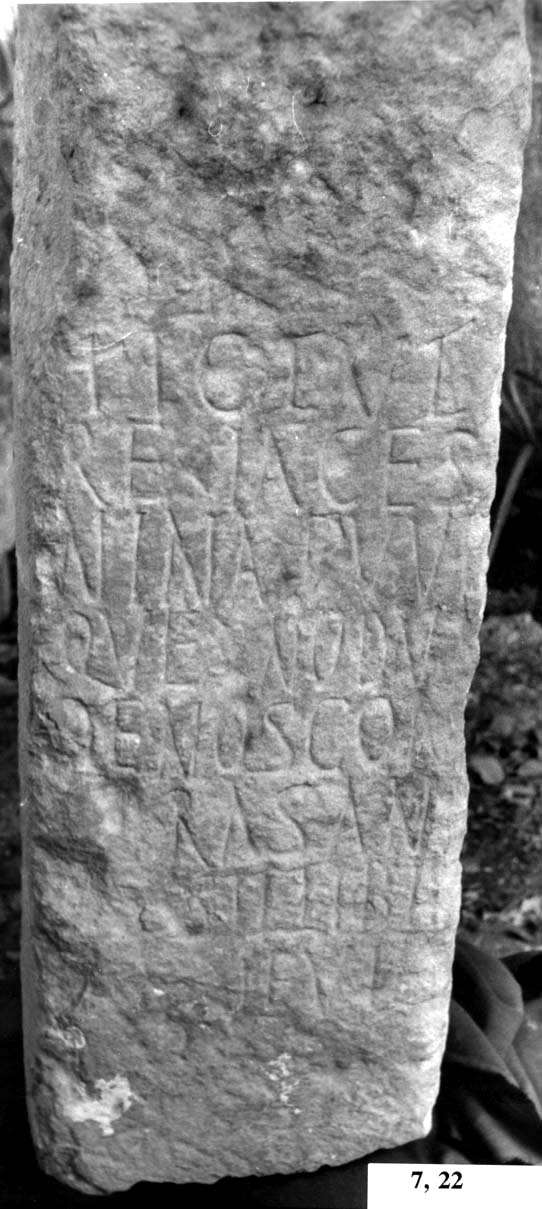Funerary inscription
Reference CIL II2/7, 22 | Description | Lyrics | Location | Chronology | Epigraphic edition | Translation | Apparatus | Comentary | Type of verse | Text divided into verses and metric signs | Images | Bibliography | Link to DB | Author |
Funerary inscription
Description
- Idno filename 22/01/0037
- Type of inscription: Sepulcralis
- Material Description: Block of whitish limestone.
- Conservation status: Damage has affected the strokes at the far left of each line. It has lost a third of its width on the right-hand side. Reused as ashlar.
- Dimensions height/width/depth (cm): 71/23/33
-
Epigraphic field:
- Layout: From l. 6, there is progressive indentation. The indentation in the left margin is 7.6 in l.6; 8.5 in l.7; and 11 in l. 8. Interpunction signs: hederae in ll. 1 - 4. L. 7 punctum.
- Preserved
Lyrics
- Font:Libraria
Location
- Place of discovery: Found in the castle-house of Jimena, on falling off one of the walls during building work JIMÉNEZ, and where it is conserved. Possibly from ager Ossigitanus, in the Cerro de Alcalá, near Mancha Real (Jaén).
- Geolocation
- Conservation location: Casa-castillo de Jimena.
- Location with Modern Nomenclature España / Jaén / Mancha Real
- Location with Old Nomenclature Hispania / Baetica / Cordubensis / Ager Ossigitanus
Chronology
- Inscription's dating: Between year 170 and year 230
- Dating explanation: End of the 2nd c. or beginning of the 3rd, from the paleography.
Type of verse
- Type of verse: Dactílico (ritmo)
- Verse/line correspondence: No
- Prose/verse distinction: No
Epigraphic edition
Hic ▴ Tut[a‑ ‑ ‑]
re ▴ iaces [‑ ‑ ‑]
nina ▴ pu{u}e[lla]
qu(a)e ▴ no<n>dun (!)[bis]
5 denos con[pleve-](!)
ras ▴ anṇ[os]
sit tibi t[erra]
levis
Text divided into verses and metric signs
Hic Tut[a ‑ ‑]re iaces [‑ ‑ ‑]nina pue[lla] ll[wll]lwl[llwwl[~]
[-] quae nondun [bis] denos conpleveras annos [l]l/ll/[l]l/ll/lww/l~
sit tibi t[erra] levis lwwlwwl
Translation
“Here you lie free of care, Tuta (...), a girl who had not yet reached twenty (?) years. May the earth rest lightly on you.”
Bibliography
Jiménez 1988, 35 (inde HEp 1993, 240, cum correctione a Stylow); Ramírez – Sánchez 1995, 327–330 et fig. 7–8 (AE 1995, 851; HEp 1996, 621); Stylow, II2/7, 22; del Hoyo in Fernández Martínez, CLEB, J12, cum im. phot, qui in linguam Hispanicam vertit; (HEp 2007, 447); Carande 2010, 230-231 (HEp 2010, 183); Cugusi 2012, 36. – Cf. Hernández Pérez 2001a, 316.
Apparatus
In v. 7 lineae verticales tres in ITT coniunctae sunt a lineis transversis superioribus et inferioribus. Litt. E in v. 8 super pedem litterae L. Finis litterae v. 1 litt. T potius quam litt. L videtur.
Suppl. Stylow. – 1 [—]FICEVI[ ] Jiménez; Hic Eut Stylow; TVL+ Ramírez – Sánchez, hic tu++ Stylow. – 2 [—]RESIA CER[—] Jiménez; res iaces Stylow. – 3 RVVI[—] Jiménez; ruun[t—] Stylow. – 4 NODV Jiménez. – 5 [—]AE NOS CON[—] Jiménez; denos com[pleverat] Stylow, fortasse supplendum com[ple]|ras proposuit Sánchez Velasco ex spatio, in II2,7 in app . – 6 ras an[nos] Stylow. – 7 [—]SI TIBI [—] Jiménez.
Comentary
Verses in dactylics with errors in prosody in which three metrical sequences can be distinguished.
Hic + onomastic of the deceased + iaces, is a formula which appears in metrical inscriptions (CLE 1753; 1440). Given that in l. 5 no more than 5 letters should be restored at the end of the line, as the end of the word is at the beginning of l. 6, we can also conjecture five letters for l. 1. We should consider the possibility of a feminine cognomen in the vocative, Tut[a] (a second declension masculine ending in -re in l. 2 would be impossible, Ramírez – Sánchez 1995, given the puuella in l. 3; and a nomen like Tul[lia] alone, with no cognomen would also be strange), and the beginning of a word which could be [mise]/re, or [secu]/re because of its frequency (cf. CLE 1959, in Madaura; CLE 499, in Ostia). -nina pue[lla] is a hexameter ending. The end of l. 2 should correspond to the beginning of the word which ends in l.3: [—]/nina. It does not appear to be a cognomen ending in -nina, since it would have been separated from the supposed nomen Tut[-] by two words. It is preferable to consider an adjective to go with puella.
The second hexameter corresponds to well-known formulae. It is missing a long syllable at the beginning of the verse, perhaps tu. Variants of this verse are found in Rome (CLE 2125); Maguncia (CLE 1100), etc. The use of the second person of the verb should be noted as compleverat always appears.
Topos of the mors immatura, with formulae learnt by rote, forgetting or adding words, thus spoiling the hexameters.
The deceased may have been a slave, Tuta, whose masculine Tutus is attested in Luz, (Lusitania, CIL II 4989), as the limitations of space suggest a very short cognomen.
The hypercorrection puuella is of note. Nodun (instead of nondum) is found in another carmen of the conventus Cordubensis (CO 23).
Author
- Author:J. Del Hoyo Calleja
- Last Update2024-02-25 18:15:29
- Autopsy date:2000
You can download this






